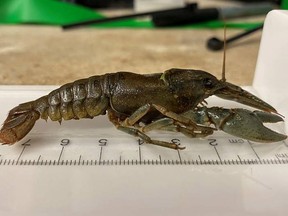'They're not supposed to be here': Invasive crayfish found in Banff National Park

Article content
Parks Canada officials are raising alarms after finding an invasive crayfish in Banff National Park, upstream from Calgary.
Ecologists captured the northern crayfish on Aug. 6 near a tributary stream flowing into Bow Lake, the source of the Bow River.
The Parks Canada aquatic invasive species team spent several days investigating a reported crayfish sighting and setting traps before snagging the crayfish, according to Megan Goudie, an aquatic ecologist with the federal agency.
“It was a female of reproductive age,” Goudie said.
“They’re not supposed to be here. Anytime there’s a species that shows up in an ecosystem it can alter the function of that ecosystem. We don’t really know what the implications of northern crayfish might be in this ecosystem, but we do know that northern crayfish can alter the food web in an ecosystem.”
The northern crayfish eats many of the same things as local species including westslope cutthroat trout and bull trout, Goudie explained. That raises concerns about food sources for those already at-risk fish.
This is the first time officials have located a crayfish in the Bow River upstream of Calgary, or in Alberta’s mountain national parks.
Officials believe the crustacean was transported to the area from elsewhere in the province. The animals are native to a small watershed on Alberta’s eastern border, but over the past decade have entered other ecosystems in the province, including as far north as Grande Prairie.
Crayfish are designated as an aquatic invasive species in Alberta, meaning they pose risk to ecosystems outside of their natural range where they may not have natural predators, meaning their population can quickly grow, harming native species.
It’s illegal both under provincial and federal law to move one of these invasive species between two bodies of water.
“It’s also illegal in Alberta to be in possession of a live crayfish,” Goudie said, adding releasing an invasive species into a National Park can carry a fine of up to $25,000.
Goudie said members of the public who come across an invasive species like a crayfish are asked to report the finding to Parks Canada, including photos and detailed information on the exact location of the sighting.
That can be done at llykaisprevention-eaeprevention@pc.gc.ca.
Twitter: @jasonfherring






Postmedia is committed to maintaining a lively but civil forum for discussion. Please keep comments relevant and respectful. Comments may take up to an hour to appear on the site. You will receive an email if there is a reply to your comment, an update to a thread you follow or if a user you follow comments. Visit our Community Guidelines for more information.